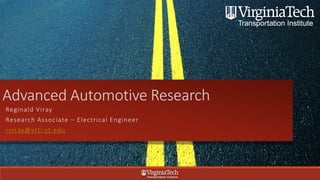Virginia Tech Transportation Institute @ Internet of Things DC Meetup - Nov 18, 2014
- 1. Advanced Automotive Research Reginald Viray Research Associate – Electrical Engineer rviray@vtti.vt.edu
- 2. Presentation Outline â—¦VTTI Overview â—¦VTTI Capabilities â—¦VTTI Projects â—¦Connected Vehicle Systems photobyLoganWallace
- 3. VTTI Overview #1 in federal grants and contracts #1 in private sector contracts Largest group of driving safety researchers in the world Over 400 employees 12 Research Centers Including: Advanced Automotive Research Automated Vehicle Systems Data Reduction and Analysis Support Sustainable Mobility Technology Development Truck and Bus Safety Motorcycle Research Group
- 4. VTTI Capabilities •System Performance •Human Factors •Human-System Integration Experimental Design •Multi-Disciplinary Engineering •Vehicle Instrumentation •Data Acquisition Technology Development •Extract, Transform, Load •Data Warehousing •High-Performance Computational Resources •Real-Time Analysis Information Technology •Data Analysis •Data Mining •Data Reduction •Algorithm Development Focused Research
- 5. photobyLoganWallace Smart Road â—¦ Officially opened in 2000 in co- sponsorship with VDOT â—¦ Closed 2.2-mile Test Bed â—¦ Over 20,000 hours of groundbreaking research â—¦ Advanced Communication & Control Systems â—¦ Differential GPS Base Station â—¦ Inclement Weather Testing (Snow, Fog, Rain) â—¦ Variable lighting configurations â—¦ Signalized Intersection
- 6. photobyLoganWallace Research Vehicles â—¦ Available for research projects â—¦ Instrumented with Data Acquisition Systems (DAS) â—¦ Diverse vehicle fleet: â—¦ Sedans â—¦ SUVs â—¦ Motorcycles â—¦ Semi-Truck â—¦ Motorcoach â—¦ Unique capabilities: â—¦ Wireless Communications â—¦ Automation
- 7. photobyLoganWallace Technology Development â—¦ Multi-disciplinary engineering center that create solutions to the ever-changing requirements of VTTI research centers and sponsors â—¦ Specializes in developing, manufacturing, implementing, and maintaining innovative systems for transportation research
- 8. Data Acquisition Systems VTTI develops state-of-the-art, data acquisition systems (DAS) that can discretely collect real- world vehicle kinematics and driver behaviors through integration of: â—¦ Vehicle CAN â—¦ RADAR â—¦ GPS â—¦ IMU â—¦ Multiple Camera Views Customizable for projects on virtually any vehicle â—¦ Heavy Vehicles â—¦ Light Vehicles â—¦ Motorcycles â—¦ Bicycles
- 9. Information Technology Multiple Data Transfer Mechanisms Petabyte Scale Scientific Data Warehouse High Performance Computational Clusters Web Enabled Data Reporting Applications In-house Developers
- 10. photobyLoganWallace Human performance contributes to more than 90% of crashes â—¦A subset of factors creates the majority of the crash risk â—¦ Impairment (primarily alcohol) â—¦ Inattention and distraction â—¦ Drowsiness â—¦ Judgment-related error â—¦Current methods of studying driver performance/behavior and their safety impacts have limitations â—¦ Detailed pre-crash information is not available from crash databases
- 11. Naturalistic Driving Studies • VTTI is the pioneer in naturalistic driving studies • Housing more than 40 million miles (>2 PB) of continuous naturalistic data (video, audio, and kinematic data)
- 12. Naturalistic Driving Studies 100-Car Study technical reports have been cited more than 1,200 times Second Strategic Highway Research Program Naturalistic Driving Study (SHRP 2 NDS) â—¦ The largest NDS ever conducted â—¦ Three-year data collection period â—¦ More than 3,100 participants, aged 16 to 98, in NY, FL, WA, NC, IN, and PA â—¦ More than 3,300 vehicles â—¦ More than 700 crashes identified to date (analyses are ongoing) â—¦ More than 5,000 near-crashes
- 13. System Performance Studies • Algorithm Development • Algorithm Assessment • Driver Acceptance
- 14. Connected Vehicle Systems â—¦ We believe connected vehicles can answer the following goals: â—¦ Improve safety â—¦ State of good repair â—¦ Economic competitiveness â—¦ Livable communities â—¦ Environmental sustainability â—¦ Key activities that will enable widespread deployment need robust research â—¦ USDOT Regional Deployment RFI â—¦ NHTSA ANPRM of vehicle-to-vehicle communications â—¦ GM deployment announcement plans â—¦ FCC activities relating to the DSRC spectrum This image first appeared on the cover of ITS International magazine, March/April 2014.
- 15. Bi-Directional Wireless Communications between Vehicles and Infrastructure â—¦ Vehicle-to-Vehicle (V2V): Bi-directional information sharing between vehicles â—¦ Vehicle-to-Infrastructure (V2I): Bi- directional information sharing between a vehicle and the roadway Wireless communication channels used â—¦ Cellular for most information that is not time critical â—¦ Dedicated short-range communications (DSRC) for low-latency, robust, secure information
- 16. Connected Vehicle Systems • DSRC SAE J2735 Standard • 5.9 GHz Band – 75MHz Bandwidth • ~300m Range • Basic Safety Messages are transmitted at 10Hz • Basic Safety Message Data Elements Include: • Latitude • Longitude • Elevation • Speed • Heading • Steering Wheel Angle
- 17. Two complimentary locations: ◦ New River Valley: ◦ Smart Road: Comprehensive instrumentation for experimental procedures in testing and developing research ◦ Northern Virginia: ◦ Fairfax County: I-66 and the parallel routes of 29 and 50 for real-world testing and development Strategic Partnership • Virginia Tech Transportation Institute • Virginia Department of Transportation • Industry Partners
- 18. Applications span myriad areas; for example: â—¦ Advanced Traveler Information System â—¦ Signal Priority â—¦ Emergency Vehicle Preemption â—¦ Queue Warning â—¦ Incident Scene and Work Zone Alerts â—¦ Probe-enabled Traffic Monitoring â—¦ Dynamic Transit Operations â—¦ Road Weather â—¦ V2V Imminent Safety The Virginia Team continues to prioritize, develop, and deploy applications
- 19. Research Sponsors Includes research sponsored by both government and vehicle manufacturer entities.




















